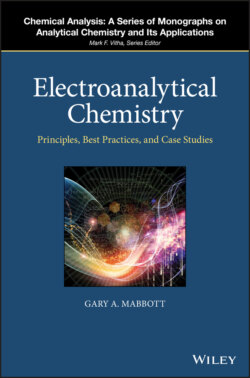Читать книгу Electroanalytical Chemistry - Gary A. Mabbott - Страница 9
Preface
ОглавлениеAlthough electroanalytical techniques are among the oldest instrumental methods used in chemistry, they continue to evolve. In the past two decades, there have been several exciting developments in the field that will ensure their relevance to chemical measurements for decades to come.
One of the growing areas in which electrochemical methods will continue to play an important role is in sensor technology. Electrochemical devices are relatively simple in terms of instrumentation and can be miniaturized. Both of these attributes help keep their costs down and make them candidates for applications such as remote sensors, personal health care monitors, and implantable devices. Some of the newer developments in both ion selective electrodes and voltammetric devices are making these sensors more selective, more robust, applicable to a wider range of analytes, and capable of lower detection limits. As simple as they may be in terms of associated hardware, these devices take advantage of a range of physical and chemical phenomena and are notable intellectual achievements. Advances in this area will require a firm grasp of the underlying science, imagination and hard work, but the possibilities are plentiful.
This book is primarily a textbook for instrumental analysis courses. As an academic subject, instrumental analysis encompasses an enormous field. It is not surprising, then, that university textbooks for instrumental analysis courses are also enormous. No one can expect to cover half of the material contained in them in a single semester. Mark Vitha has initiated a series of monographs as an alternative approach in which instructors can choose only those volumes covering topics that they intend to use in their own classes. The purpose of this book is to provide an option for teaching electroanalytical methods as a part of that series.
Space and instruction time allow for the inclusion of only a fraction of the interesting material in the electroanalytical field here. I have made some compromises in order to make covering the content manageable within a few weeks as well as provide a glimpse at some of the intriguing applications of electrochemical measurements. I have tried to emphasize the conceptual models of physical phenomena and make clear connections to mathematical descriptions that are useful. It is important to see how practicing scientists have used the math to extract useful information about chemical systems. I have tried to guide the reader with an overview of the most important ideas at the beginning of each chapter. Some basic concepts in electrical phenomena are introduced in Chapter 1, and the fundamentals of electrochemical cells are introduced in Chapter 2. Chapter 3 describes potentiometry, and Chapter 5 lays out the principles of voltammetry. Both Chapters 3 and 5 include example applications, but Chapters 4 and 6 provide case studies that demonstrate a lot of the best practices that good chemical analysis depends upon. Chapter 7 describes basic electrical circuitry and the use of operational amplifiers that are essential parts of electrochemical instrumentation.
Although this appears to be more material than is easy to cover in a few weeks of a single course, the overview explains which sections to concentrate on, if time is limited. I wanted to let instructors decide on what supporting material and case studies to cover to meet their needs. I hope that students will find the application material engaging. The material should also be relevant to scientists from other fields who need an introduction to the area of electrochemical analysis.
I want to thank Mark Vitha for including me in this project. His energy, insight, and tenacity for getting things done have been an inspiration for me for many years. Several people have read early drafts of various material for this book. I am particularly grateful to Mark, Larry Potts, Maggie Malone‐Povolny, Wayne Boettner, and Joe Brom for their feedback. Each of them has had a different perspective and has made helpful comments. I am also grateful to Phil Bühlmann for his encouragement and insightful comments. I want to thank all the people at Wiley who have helped me in many ways, but Gayathree Sekar deserves special thanks for answering my questions and managing a myriad of things to see this book through production.
Finally, I want to thank my wife, Ann, for all her love and patience. This project would not have been possible without her support and understanding.
Gary A. Mabbott
St. Paul, Minnesota, USA
June 9, 2019
